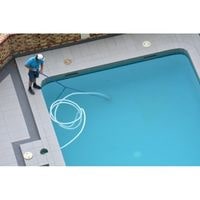How to clean above ground pool. Improving your swimming experience can be challenging, but it doesn’t have to be a DIY job.
New technology has resulted in a host of above-ground pool cleaners that will give you and your family the ease of mind that comes with knowing your pool is looking its best at all times.
Want to ensure your pool is shimmering rather than slimy? Check out these tips on cleaning an above ground pool:
How to clean above ground pool

To make sure your above-ground pool stays clean you’ll need to find a way to get rid of some debris that might enter it.
The first thing that you can do is try running your filter pump for at least 8 hours a day to circulate the water and remove debris.
You should also get in the habit of emptying the basket from the pump once a week and dumping out all of the debris before hosing it off before replacing it.
Check out these tips for cleaning your above-ground pool.
Let’s start with the pump
Water circulation is vital to the health and clarity of your pool water, just as blood circulation is key to the health of your heart.
A pump can help circulate water. Like a heart, a pool pump circulates water around the swimming pool.
Your pump should be able to force your pool’s water to circulate through it every eight hours. Every drop of water that goes into the swimming pool should go through the pump at least once in eight hours’ time.
If you want your swimming pool’s water squeaky clean, then you need this circulation of fresh particles entering back into the depths again so that they can be filtered out by way of a filter and scrubber system.
So it’s paramount that your pool pumps turn over regularly, at least six hours every day for example.
Filter
If your pool is the heart of your backyard, then the filter system is the heart’s blood that makes it all run smoothly. Water filtration is essential because the water people are swimming in isn’t always clean water.
So having a way to make sure that it remains free from germs, pollutants and other unwanted elements is imperative to protect kids and family health.
There are many types of filters for pools. Some filter systems extract the water from the pool through a pump, filter it, and then redirect it back into the pool.
What these systems tend to do is capture everything from sand to oils from swimmers themselves.
The water that makes its way through such a system will be clean, clear, and pristine! In other kinds of pools.
like spa pools, some may use a filtration system that works with sometimes heat or no heat at all by forcing water (and debris) through small holes in mesh cloth, so as not to burn or damage the filter itself. These systems also rely on tiny particles known as Diatomaceous Earth (or D.E., for short).
Cleaning with a vacuum and a brush

It’s important to keep the entire pool clean because there are areas of your pool that might have trouble circulating water. When these areas are avoided.
They can become a cozy home for algae to grow in and excessive algae growth can be unsightly, as well as damaging to pools made from vinyl liners.
Vacuuming or brushing a vinyl liner every week will prevent this problem from occurring.
Preserving pH levels and chlorine concentrations
Your pool is a delicate environment, which means you have to keep an eye out for things that might affect it negatively.
On top of that, how will you know something’s wrong if you don’t pay attention to the living being that is your pool?
Among other things, your pool needs to be properly maintained and this includes checking its water levels. There are different levels of water in your pool, including pH levels and sanitizer.
The latter is significantly more important for big pools or public pools. You should test the water approximately three times a week (or every other day), but always remember to check the weather report before doing so.
For example: when using a chlorine-based chemical, the optimal time to maintain levels of sanitizer in your pool is on days with no rain within the last 48 hours and temperatures above 65 degrees Fahrenheit.
This way, you’ll have enough time to add chemicals or adjust your machines appropriately based on what you find in said test results.
Adding a little shock to the pool
Even when all of your water chemistry is perfect and your pool has a well-balanced pH, chlorine levels can still fall.
The most common culprit is unwanted chemicals in the water from showering, swimming, or regular wear and tear.
It’s absolutely vital to make sure your customers use natural products for washing their bodies when getting into the pool to help reduce compounds that could end up hindering the effectiveness of your disinfectant (chlorine).
In addition to the nasty problems on the skin having chemicals present in a pool can cause (like rashes, itchy eyes, and overall irritation), keep in mind all sorts of new compounds may be created when these unwanted elements react with chlorine.
By shocking this mixture often (with a dosage of 10-20 PPM shock) you can effectively oxidize these potentially harmful chemical reactions and free up chlorine so it can start working as intended again.
Related Guides
